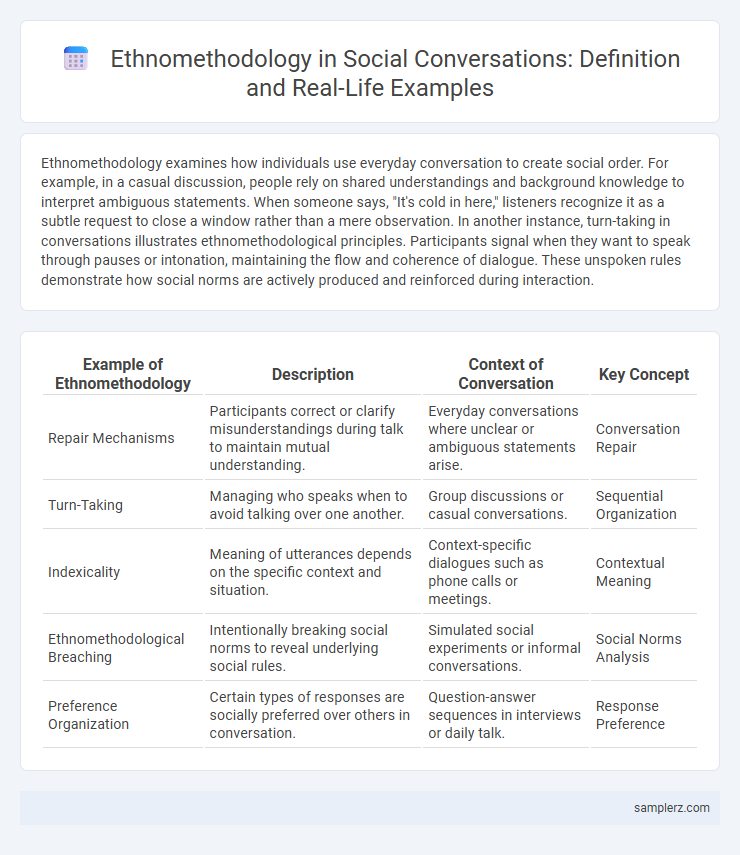Ethnomethodology examines how individuals use everyday conversation to create social order. For example, in a casual discussion, people rely on shared understandings and background knowledge to interpret ambiguous statements. When someone says, "It's cold in here," listeners recognize it as a subtle request to close a window rather than a mere observation. In another instance, turn-taking in conversations illustrates ethnomethodological principles. Participants signal when they want to speak through pauses or intonation, maintaining the flow and coherence of dialogue. These unspoken rules demonstrate how social norms are actively produced and reinforced during interaction.
Table of Comparison
| Example of Ethnomethodology | Description | Context of Conversation | Key Concept |
|---|---|---|---|
| Repair Mechanisms | Participants correct or clarify misunderstandings during talk to maintain mutual understanding. | Everyday conversations where unclear or ambiguous statements arise. | Conversation Repair |
| Turn-Taking | Managing who speaks when to avoid talking over one another. | Group discussions or casual conversations. | Sequential Organization |
| Indexicality | Meaning of utterances depends on the specific context and situation. | Context-specific dialogues such as phone calls or meetings. | Contextual Meaning |
| Ethnomethodological Breaching | Intentionally breaking social norms to reveal underlying social rules. | Simulated social experiments or informal conversations. | Social Norms Analysis |
| Preference Organization | Certain types of responses are socially preferred over others in conversation. | Question-answer sequences in interviews or daily talk. | Response Preference |
Understanding Ethnomethodology in Social Conversations
Ethnomethodology examines how individuals use everyday language and social cues to create mutual understanding during conversations. By analyzing turn-taking, repair mechanisms, and contextual knowledge, ethnomethodologists reveal the implicit rules people follow to maintain coherence and social order. This approach highlights the practical methods participants employ to interpret meaning and negotiate shared reality in real-time interactions.
Everyday Talk: Ethnomethodology’s Core Examples
Ethnomethodology's core examples in everyday talk include analyzing how participants use turn-taking, repair mechanisms, and indexical expressions to create mutual understanding in conversations. The study of conversational sequences, such as question-answer exchanges and storytelling, reveals how social order is produced and maintained through routine interactions. Detailed examination of pauses, overlaps, and laughter exposes underlying social norms and contextual meanings embedded in daily communication.
Turn-Taking: How Conversation Order Emerges
Ethnomethodology reveals how turn-taking in conversation emerges through participants' use of subtle cues such as intonation, eye gaze, and pauses to signal when they intend to speak or yield the floor. This method highlights the implicit social rules that govern the orderly exchange of turns without explicit agreement, enabling smooth interaction. Studies show that deviations from these norms often result in overlapping speech or awkward silences, illustrating the importance of shared understanding in conversational order.
Repair Mechanisms in Daily Dialogue
Ethnomethodology in conversation examines repair mechanisms as essential processes where speakers identify and resolve communication breakdowns to maintain mutual understanding. These mechanisms include self-repair, where individuals correct their own speech, and other-repair, where interlocutors assist in clarifying or correcting utterances. Repair strategies contribute to the smooth flow of daily dialogue by addressing misunderstandings, word searches, and pronunciation errors in real-time interaction.
Establishing Meaning: Context and Shared Understanding
Ethnomethodology in conversation examines how individuals use context and shared understanding to establish meaning through everyday interactions. For example, conversational participants rely on implicit social cues and background knowledge to interpret ambiguous statements accurately. This process highlights the importance of mutual comprehension and social norms in constructing coherent communication.
Managing Silence and Pauses in Interaction
Ethnomethodology examines how individuals use silence and pauses as meaningful components in conversation to manage turn-taking and signal social cues. These pauses can indicate hesitation, agreement, or a need for reflection, influencing the flow and interpretation of interaction. Understanding the function of silence helps reveal underlying social norms and participant expectations in everyday communication.
Sequential Organization in Social Talk
Ethnomethodology examines the Sequential Organization in Social Talk by analyzing how speakers manage turn-taking, repair breakdowns, and maintain coherence during conversations. For example, when a listener detects a misunderstanding, they initiate a repair sequence to clarify meaning, demonstrating participants' shared methods for producing intelligible talk. This approach reveals the implicit rules and structures that organize everyday interactions in social settings.
Indexicality: Words Shaped by Social Setting
In ethnomethodology, indexicality illustrates how words acquire meaning based on the social setting of a conversation, as demonstrated when phrases like "over there" depend on shared context between speakers to be understood. This concept highlights how interlocutors use situational cues and mutual knowledge to interpret references that lack fixed definitions outside the immediate environment. Such context-dependent language underscores the fluid and dynamic nature of meaning-making within everyday social interactions.
Politeness Strategies Through Ethnomethodological Lens
Ethnomethodology examines how politeness strategies in conversation are socially constructed and maintained through everyday interactions, highlighting the subtle methods participants use to manage face and avoid conflict. For example, speakers often employ indirect requests or mitigated speech as practical techniques to show respect and preserve social harmony. These methods reveal the underlying social norms and shared understandings that govern polite communication within specific cultural contexts.
Negotiating Identity in Conversational Exchanges
Ethnomethodology examines how individuals use everyday conversational practices to negotiate and construct their identities in social interactions. Through subtle linguistic cues, turn-taking, and repair mechanisms, speakers collaboratively establish and affirm social roles and personal identities. This approach reveals the dynamic process of identity formation as participants continuously interpret and respond to each other's verbal and nonverbal signals within conversations.

example of ethnomethodology in conversation Infographic
 samplerz.com
samplerz.com